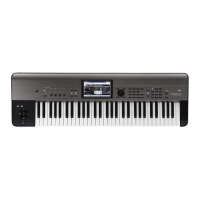PROG P1: Basic/Controllers 1–2: Note-On/Scale
15
In general, when you use the KeyOff setting, it’s also best to
set the oscillator’s Amp EG Sustain Level to 0.
Mode [Key, Key + Damper]
Normally, you play notes simply by pressing keys on the
keyboard. In special cases, however, you can set this
parameter so that you must first be holding down the
damper pedal, and then press a key, in order to play a note.
For instance, this can be useful when modeling the behavior
of a piano soundboard.
Key is the normal mode.
When you select Key + Damper, notes will only sound if the
damper pedal is being held down. When the damper pedal
is released, all notes will be stopped even if they are still
being held down.
OSC2 Delay [0000ms...5000ms, KeyOff]
Mode [Key, Key + Damper]
This specifies the time from when you press a key until
oscillator 2 actually begins to sound.
See OSC1 Delay and Mode, above.
1–2d: Scale
Type
[Equal Temperament…User Octave Scale15]
Selects the basic scale for the Program.
Note that for many of the scales, the setting of the Key
parameter, below, is very important.
Equal Temperament: This is the most widely used scale by
far, in which each semitone step is spaced at equal pitch
intervals.
Equal Temperament allows easy modulation, so that a chord
progression played in the key of C sounds roughly the same
as the same progression played in F#. Sacrificed, however, is
some of the purity of individual intervals offered by the
scales below.
Pure Major: In this temperament, major chords of the
selected key will be perfectly in tune.
Pure Minor: In this temperament, minor chords of the
selected key will be perfectly in tune.
Arabic: This scale includes the quarter‐tone intervals used in
Arabic music.
Pythagoras: This scale is based on ancient Greek music
theory, and is especially effective for playing melodies. It
produces completely pure fifths, with one exception, at the
expense of detuning other intervals– thirds in particular.
As much as Pythagoras might have liked to do so, it’s not
possible to make all the fifths pure while also keeping the
octave in tune. For the sake of the octave, one of the fifths the
interval from the sharp fourth degree to the sharp first
degree is made quite flat.
Werkmeister (Werkmeister III): This scale was one of the
many temperament systems developed towards the end of
the Baroque period. These “Well‐Tempered” tunings were
aimed at allowing relatively free transposition although
you’ll still notice that the different keys maintain their own
distinct characteristics, unlike Equal Temperament.
J.S. Bach was referring to these new scales in his title, “The
Well‐Tempered Clavier.” As such, this group are
particularly appropriate for late baroque organ and
harpsichord music.
Kirnberger (Kirnberger III): This is a second “Well‐
Tempered” tuning, dating from the early 18th century.
Slendro: This is an Indonesian gamelan scale, with five
notes per octave.
When Key is set to C, use the C, D, F, G and A notes. Other
keys will play the normal equal‐tempered pitches.
Pelog: This is another Indonesian gamelan scale, with seven
notes per octave.
When Key is set to C, use the white keys. The black keys will
play the equal tempered pitches.
Stretch: This tuning is used for acoustic pianos.
User All Notes Scale: This is a user‐programmed scale with
different settings for all 128 MIDI notes. You can set up this
scale in Global mode (Global 3–1b).
User Octave Scale 00–15: These are user‐programmed scales
with settings for each of the 12 notes in an octave. You can
set them up in Global mode (Global 3–1a).
Key (Scale Key) [C…B]
Selects the key of the specified scale.
This setting does not apply to the Equal Temperament,
Stretch, and User All Notes scales.
If you’re using a scale other than Equal Temperament,
the combination of the selected scale and the Key
setting may skew the tuning of the note. For example, A
above middle C might become 442 Hz, instead of the
normal 440 Hz. You can use the Global Mode’s Master
Tune (Global 0–1a) parameter to correct this, if
necessary.
Random [0…7]
This parameter creates random variations in pitch for each
note. At the default value of 0, pitch will be completely
stable; higher values create more randomization.
This parameter is handy for simulating instruments that
have natural pitch instabilities, such as analog synths, tape‐
mechanism organs or acoustic instruments.
V
1–2: Menu Command
•0: Write Program see p. 64
•1: Exclusive Solo see p. 64
•2: Auto Song Setup see p. 65
•3: Copy Oscillator see p. 65
•4: Swap Oscillator see p. 65
For more information, please see “Program: Menu
Command” on page 64.

